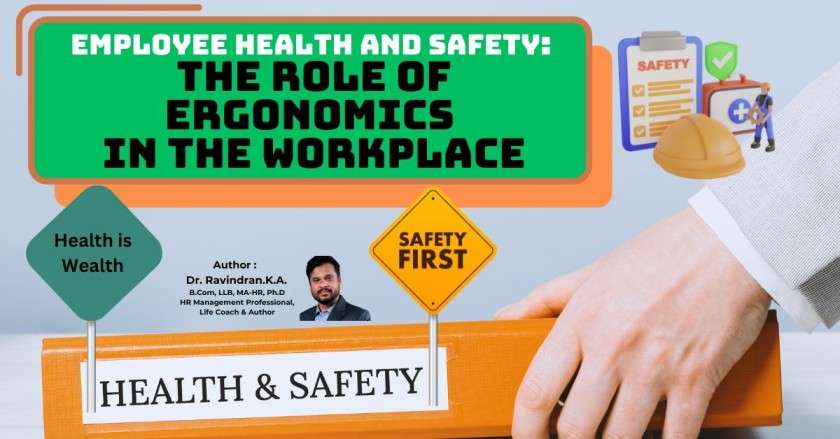The Impact of Workplace Environment on Employee Health and Safety
In today’s fast-paced business world, many overlook how the workplace affects employee health and safety. But how big is this effect, and what can companies do to make work safer and healthier? Looking into this could help boost productivity, cut costs, and make workers more engaged and loyal.
Thank you for reading this post, don't forget to subscribe!Key Takeaways
- The workplace environment greatly affects employee health, safety, and well-being.
- Bad environmental conditions like poor air quality, loud noises, and dim lighting can cause health issues.
- Good work cultures can lessen stress, anxiety, and burnout in employees.
- Good health and safety programs can cut illness and injury rates by 20-40%.
- Putting employee safety first can build trust, loyalty, and improve a company’s brand value.
Understanding the Workplace Environment
The workplace has many important parts, like lighting, ventilation, noise, and ergonomics. These physical factors greatly affect workers’ health, safety, and happiness.
Good lighting helps avoid eye strain and headaches. Enough ventilation keeps the air clean and cuts down on breathing problems. And, keeping noise levels low is key to preventing hearing issues and stress.
Ergonomic Design
Ergonomic design means making the workspace fit the human body. It’s key to stop musculoskeletal disorders like back pain and carpal tunnel syndrome. Badly designed workspaces and furniture can lead to these problems, hurting workers’ productivity and life quality.
By using ergonomically designed workspaces and furniture, companies help workers stay in good posture. This reduces the risk of repetitive strain injuries. It also boosts their physical health and happiness.
“70% of managers’ report that organizational obstacles hinder them from supporting their team members’ well-being efficiently.”
Creating a healthy and safe physical space is key to a positive work culture and supporting employee well-being. Companies that focus on these physical factors make a place that boosts productivity, engagement, and happiness among employees.
The Role of Organizational Culture
The culture at work deeply affects how employees feel mentally and emotionally. A supportive culture helps employees feel good. But a bad culture with bullying or harassment can make people stressed and burnt out.
To make a positive work culture, focus on a good work-life balance. Celebrate employee wins, offer chances for growth, and make sure they feel involved. This makes employees feel important, motivated, and happy with their jobs.
Also, having mental health support like counseling or stress workshops helps. These programs help with work stress and mental health issues. They lower the chance of long-term mental health problems.
| Organizational Culture Impact | Positive Impact | Negative Impact |
|---|---|---|
| Employee Wellbeing | Fosters employee wellbeing | Leads to stress, anxiety, and burnout |
| Work-Life Balance | Promotes healthy work-life balance | Contributes to work-related stress |
| Employee Engagement | Encourages employee engagement | Disengaged and demotivated employees |
| Mental Health Support | Provides mental health programs | Lack of support for mental health issues |
Creating a positive organizational culture is key. It means focusing on employee wellbeing, balance, engagement, and mental health support. This leads to a healthy, productive workplace.
“A positive company culture not only benefits employees, but it also has a direct impact on the bottom line. Organizations with strong cultures experience higher productivity, lower turnover, and greater profitability.”
Impact of Workplace Environment on Employee Health and Safety
The workplace environment greatly affects the health and safety of employees. Things like workplace hazards, occupational health risks, and work-related stress can harm employee wellbeing. This can lead to employee burnout, absenteeism, and presenteeism.
Poor air quality, loud noises, and bad lighting can cause headaches, fatigue, and breathing problems. Studies show that workplace features like lighting, ventilation, and sound levels affect how happy, productive, and satisfied employees are. Also, nine out of ten workers think the quality of their workplace makes them more productive.
The culture at work also affects how employees feel mentally and emotionally. A bad work culture with bullying, harassment, or discrimination can make people stressed, anxious, and burnt out. This can lead to less work done, more absenteeism, and presenteeism.
But a good work culture that supports work-life balance, recognizes employees, and offers growth chances can boost engagement, motivation, and job satisfaction. This can make employees healthier and happier.
“Effective workplace communication can lead to increased productivity, less confusion, and a more positive attitude towards work.”
Supervisors are key in supporting employees, giving them what they need, and praising them for their work. By focusing on both the physical and cultural aspects of the workplace, companies can make a healthier and more productive place for their employees.
Implementing Wellness Programs
Promoting employee wellness is key to a healthy and productive work life. By offering wellness programs, companies can boost their workers’ health and happiness. This leads to lower healthcare costs, more productivity, and happier employees.
Health Screenings, Fitness Classes, and Mental Health Support
Wellness programs come in many forms. They include health screenings, fitness classes, and mental health support. Health screenings spot health issues early, helping employees take steps to prevent chronic diseases. Fitness classes and physical activities encourage a healthy lifestyle, cutting down on chronic disease risks. Mental health support, like counseling and stress workshops, helps employees deal with work stress and mental health issues.
Research shows that companies with wellness programs have lower healthcare costs. These programs also reduce absenteeism and lower healthcare costs when done right. Plus, offering wellness programs helps companies attract and keep top employees, even with different health plans.
“Investing in employee wellness programs can improve employee engagement at work, leading to increased productivity.”
Putting employee health first creates a positive work environment. It boosts employee happiness and satisfaction. This leads to more productivity and profits. Programs that cover physical, mental, and emotional health greatly improve the workforce’s health and engagement.
Strategies for Creating a Healthier Workplace
Making a workplace healthier is a big task that needs to look at both the physical and cultural sides. By using different strategies, companies can make a place that helps employees stay well, work better, and values wellness.
Enhancing the Physical Work Environment
Improving the physical space at work is key to a healthier workplace. This means making the lighting, air, temperature, and design better for everyone. A comfy workspace boosts motivation, well-being, and healthy habits.
Promoting Work-Life Balance
It’s vital to help employees balance work and life for their engagement and well-being. By offering flexible hours, remote work, and plenty of paid leave, companies can help employees keep a good balance.
Cultivating a Positive Organizational Culture
Building a positive work culture with respect, open talk, and recognizing employees makes a big difference. High-trust companies see 260% more motivation, 41% less absenteeism, and 50% less job searching.
Offering Wellness Programs and Resources
Health screenings, fitness classes, mental health support, and wellness programs help employees stay healthy. Supporting healthy habits boosts productivity and cuts down on sick days and accidents at work.
Ensuring Regulatory Compliance and Best Practices
Following safety and health laws and using the best practices is key for keeping employees safe and healthy. A healthy workplace leads to better work and lower costs from sick days, turnover, and medical claims.
By using these strategies, companies can make a workplace that supports employee health, boosts productivity, and encourages wellness.

“Companies with highly aligned cultures and innovation strategies see 30% higher enterprise value growth and 17% higher profit growth.”
Regulatory Compliance and Best Practices
Keeping up with regulatory compliance and following industry best practices is key for a safe and healthy workplace. In India, the Occupational Safety and Health (OSH) Standards and Factories Act Safety regulations guide us. They help protect employees from dangers at work and keep them healthy.
Occupational Safety and Health Standards
These OSH standards cover many areas, including:
- Workplace hazard identification and risk assessment
- Engineering controls and personal protective equipment
- Occupational health monitoring and medical surveillance
- Emergency preparedness and response planning
- Employee training and awareness on safety protocols
Following these OSH standards and best practices helps reduce the risk of accidents and illnesses at work. It also builds a safety-focused culture among employees. Keeping up with new rules and best practices helps tackle health and safety issues early. This boosts employee morale, productivity, and the overall success of the organization.
| Key Statistic | Value |
|---|---|
| Annual cost of work-related incidents to the global economy | $3 trillion |
| Workers who die annually due to occupational accidents or work-related diseases | Over 2.3 million |
| Companies that have implemented effective workplace health and safety management systems | Improved safety performance and reduced incidents, near misses, and fatalities |
“Establishing effective workplace health and safety management systems can help avoid risks in high-risk industrial sectors.”
Conclusion
The workplace greatly affects employee health and wellbeing. A good work environment boosts morale, engagement, and productivity. It includes proper lighting, air flow, ergonomic design, and a positive culture.
Wellness programs like health checks, fitness classes, and mental support help employees stay healthy. Following safety laws and industry standards is also key for a safe workplace.
By focusing on health and safety, companies can make their employees happier and work better. A healthy workplace helps employees and makes the company more successful and sustainable in the long run.
FAQ
What is the impact of the workplace environment on employee health and safety?
The workplace environment greatly affects employee health and safety. Bad work environments can cause headaches, fatigue, and even chronic illnesses. On the other hand, a good work environment boosts morale, engagement, and productivity.
What are the physical factors that impact the workplace environment?
Physical factors like lighting, temperature, air quality, noise, and ergonomic design shape the workplace. Good lighting and ventilation reduce health risks. Ergonomic design prevents musculoskeletal disorders.
How does the organizational culture impact employee mental and emotional health?
The work culture affects employee mental and emotional health. A supportive culture boosts wellbeing. But a negative culture can cause stress, anxiety, and burnout.
What are the negative impacts of poor workplace environments on employee health and safety?
Bad work environments harm employee health and safety. Poor air quality and high noise levels cause health issues. A negative work culture also affects mental wellbeing, leading to stress and burnout.
How can wellness programs and resources benefit employee health and wellbeing?
Wellness programs like health screenings and fitness classes help employees stay healthy. Mental health support reduces stress and depression risks. These programs improve overall wellbeing.
What strategies can organizations implement to create a healthier workplace environment?
To improve the workplace, focus on the physical environment, work-life balance, and a positive culture. Offer wellness programs and follow safety standards. These steps create a healthier work environment.
Why is regulatory compliance and adherence to industry best practices important for workplace health and safety?
Following safety standards and best practices is key for a safe workplace. In India, OSH Standards protect employees. By following these, organizations reduce accidents and promote safety culture.
 hroptimum
hroptimum





